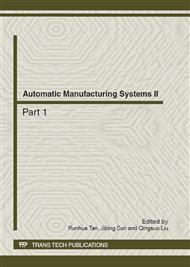[1]
Shan, Satywadi. Computer-Aided Component Selection for Precision Assembling. 10th International Conference on Production Research. 1989:734-739
Google Scholar
[2]
Kannan SM, Jayabalan V. Genetic algorithm for minimizing assembly variation in selective assembly. International Journal of Production Research. 2003, 41(14):3301–3313
DOI: 10.1080/0020754031000109143
Google Scholar
[3]
Kannan SM, Jeevanantham AK, Jayabalan V. Modeling and analysis of selective assembly using Taguchi's loss function. International Journal of Production Research. 2008, 46(15):4309–4330
DOI: 10.1080/00207540701241891
Google Scholar
[4]
Hag-Soo Kim. Analysis of Selective Assembly Operations in Manufacturing. A Dissertation for the Doctor Degree of Northwestern University. (1994)
Google Scholar
[5]
Fang XD, Zhang Y. A new algorithm for minimizing the surplus parts in selective assembly. Computers and Industrial Engineering. 1995,28(2):341–350
DOI: 10.1016/0360-8352(94)00183-n
Google Scholar
[6]
Shun Masuura, Nobuo Shinozaki. Optimal bining strategies under squared error loss in selective assembly with measurement error. Communication in Statistics-Theory and Methods. 2007, 36:2863-2876
DOI: 10.1080/03610920701386984
Google Scholar
[7]
Chan, K. C.;Linn ,R.J. A grouping method for selective assembly of parts of dissimilar distributions. Qual. Eng. 1998, 11(2), 221-234.
DOI: 10.1080/08982119808919233
Google Scholar
[8]
Liu Jian-dong, Chang Zhi-yong. Computer aided selective assembly model for multi-dimension chains. Computer Integrated Manufacturing Systems. 2008, 5 (14):855-860.
Google Scholar
[9]
J. Kennedy and R.C. Eberhart. Particle Swarm Optimization. IEEE International Conference on Neural Networks, Perth, Australia, IEEE Service Center, Piscataway, NJ, 1995.
Google Scholar
[10]
J. Kennedy and R.C. Eberhart. Swarm Intelligence. Morgan Kaufmann Publishers, ISBN: 1-55860-595-9, 2001.
DOI: 10.1007/s00897020553a
Google Scholar
[11]
Kennedy J, Eberhart C. Particle swarm optimization. Proc. of IEEE International Conference on Neural Networks, USA: IEEE Press. 1995, 4:1942-1948
Google Scholar
[13]
R.C. Eberhart, and Y. Shi. Comparison between Genetic Algorithms and Particle Swarm Optimization, Evolutionary Programming VII, Lecture Notes in Computer Science 1447, Springer, 1998,611-616.
DOI: 10.1007/bfb0040812
Google Scholar
[14]
Asha A, Kannan SM, Jayabalan V. Optimization of clearance variation in selective assembly for components with multiple characteristics. Int J Adv Manuf Technol. 2008, 38:1026-1044
DOI: 10.1007/s00170-007-1136-3
Google Scholar


